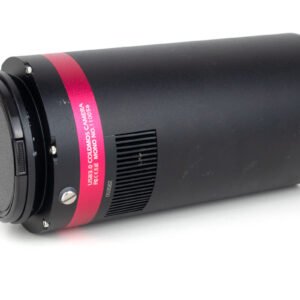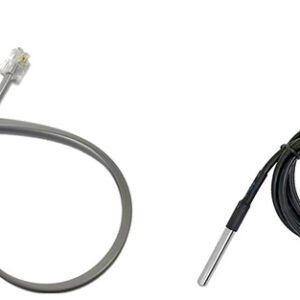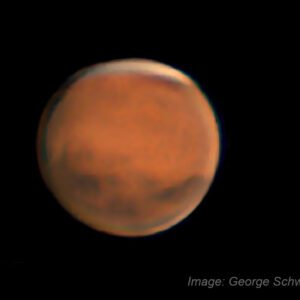If you’ve got a camera and you’ve been out at night, chances are you’ve thought about getting photographs of what’s above you. It’s only natural.
You can start with a plain camera and tripod, and take a long exposure, and you’ll get something like the two photos here.


But if that’s not what you’re after, and you need a much deeper image, but without star trails, you need to rotate your camera in a very specific direction at a very specific rate. In this article, I’ll talk about three types of machine that do this, each with varying levels of sophistication.
The machines I’m talking about are trackers, guiders and equatorial mounts. I’ll describe three different types and their differences below, but the three gadgets have a couple of things in common:
- they need to be lined up with the celestial pole – in a process called polar alignment
- they rotate the camera around this polar axis – that astronomers call right ascension – to compensate for the Earth’s rotation
Once the machine is carrying your camera and rotating it, you camera can point at any star, and it will continue to point at that star as the machine rotates. This means you can (in theory, at least) expose for as long as you like and no star in your field will move from the spot. Through the wonders of CMOS, the darkest nebulas will become visible.
Trackers
The first type of machine is known as a tracker. Examples include the iOptron SkyTracker Pro, Sky-Watcher Star Adventurer Mini, or the Vixen Polarie. You can see one of these, the iOptron SkyTracker Pro, on the left of the image at the top.
A tracker is the simplest method for preventing star trails. It rotates the the camera at the rate the stars appear to move (this is called the sidereal rate). For them to work correctly, you have align the camera’s axis with the celestial pole.
A tracker can be as basic as two bits of wood connected by a hinge with a bolt that opens the hinge. This is called a “barn door tracker”, and it can work remarkably well. With barn doors, getting the rotation rate to be not only correct, but constant can be difficult enough, but the real challenge is to get them lined up accurately with the Earth’s rotation.
More sophisticated trackers are driven by stepper motors and can be very accurate. They can also come with different aids to help you with polar alignment, such as polar scopes (which help you find the celestial poles by aligning relevant stars with a reticule), or even electronic alignment aids like cameras that talk to a computer.
The limiting factor with a tracker is that they can only follow the star westwards at a set rate. If, for some mechanical reason, your tracker slows down or speeds up, it has no way of compensating. What’s more, if your polar alignment isn’t perfect, the tracker can’t help. Your stars will become elongated.
Guiders
The second group of machines is known as guiders. Examples include the iOptron SkyGuider or Sky-Watcher Star Adventurer. The mount in the centre of the photo is an iOptron SkyGuider. Guiders are a little more sophisticated.
A guider is similar to a tracker in that it only moves in one axis, right ascension (RA). However, motors are never perfect, so the speed of the motor can vary. If you can detect when the rate of rotation is too fast or too slow, you can speed the motor up or slow it down to compensate. Most guiders need you to provide the small scope and camera to sense when the camera is rotating too fast or slow. This is called an autoguide system and it also needs a computer (either a laptop or a mini computer such as a Raspberry Pi or NUC). You need the laptop running with the guider for the entire time you’re capturing images.
You use a guider in a very similar way to a tracker, including aligning with either a polar scope or electronic aids. Typically, they do not come with guide scopes or cameras, and so out of the box, the RA axis just moves at a steady sidereal rate. This means that without the autoguide system, a guider is so similar to a tracker as to be indistinguishable. To get the best out of the guider you need that extra equipment.
With the autoguider, it can speed up or slow down its east-west tracking rate, but a guider can’t move itself in the other axis, declination. So if your polar alignment is poor, your guider won’t be able to completely compensate for drift, leaving you with stars elongated in a north-south direction.
Equatorial mounts
The final group of machines here is equatorial mounts. These (or at least the “go-to” ones with motors) are pretty much the logical conclusion of development here. There are dozens of motorised equatorial mounts from a wide range of brands, (such as iOptron, Sky-Watcher, Celestron, Rainbow Astro, or Astro-Physics). These are the most comprehensive way to track the stars, but they tend to be used more with telescopes than cameras and lenses.
The way to get the best image is to have motors to move in both axes: not just right ascension, but also declination. This is what an equatorial mount does.
Like trackers and guiders, an equatorial mount continually moves its right ascension westwards to compensate for the Earth’s rotation. If the mount has an autoguide system, it can instruct the mount’s RA motor to speed up or slow down to compensate for inaccuracies in the mount’s rotation rate.
But in addition to trackers and guiders, an equatorial mount is able to move in declination axis as well. If the autoguide system detects that the mount is drifting north or south of the target, it can move the declination motor, switching north and south to follow the target.
Equatorial mounts still need to have good polar alignment because, while they can correct for mechanical or other deviations, poor polar alignment will cause field rotation, meaning the stars on the outside of the photo will rotate around the star in the centre of the frame. This is, incidentally, also the reason why alt-azimuth mounts are not suited for long exposure astrophotography.
Finally, equatorial mounts have historically been large and heavy, but recently, astroequipment companies have been developing a range of very small full go-to equatorial mounts, such as the iOptron SkyHunter or the Sky-Watcher Star Adventurer GTi. These mounts are similar in size to sky trackers and guiders, and typically have the capacity for a camera and lens, or at most, a small refractor. That’s an iOptron SkyHunter on the right of the image at the top.
Assessing the images
I got this image from a light-polluted suburb in Melbourne. It includes the Rho Ophiuchi cloud complex, and the bright star is Antares in Scorpio. The tracker I used was an iOptron SkyTracker Pro, and for polar alignment I used the iPolar camera. This meant that while I was setting the machine up, I needed a laptop to connect to the iPolar camera. Once I was aligned, however, I put the computer away.
To assess the image, we need to have a very close look at the stars in the corners and in the centre. I’ve blown them up and arranged the five panels here.
You’ll see that the stars in the corners are elongated away from the centre of the image. This shows that there’s a noticeable coma problem in the lens, an elderly Pentax 50mm f/1.8, but it doesn’t show much about the performance of the tracker. You’ll also notice quite a lot of dust, probably on the lens or a filter. I do clean my stuff occasionally, just not recently! (Incidentally, a type of calibration image called a “flat frame” can allow my computer to compensate for these marks.)
To assess the quality of the image, we’ll examine the stars in the centre of the image, and look for elongation, and in particular, the direction of elongation. If our polar alignment was out, you’d see a drift, predominantly in a north-south direction. Alternatively, if the tracker was moving at the wrong rate, we’d see a drift in an east-west direction.
Look at the stars in the centre of the image. They’re pretty round. This indicates two things. First, the tracking direction was correct, and this was due to the good polar alignment (thanks to the iPolar). Second, the tracking rate was accurate. I was in the city when I took this so I wasn’t able to go longer than 30 second exposures, but clearly I could have tracked for much longer. (In the city, light pollution will quickly flood the camera.)
As a comparison, here’s a five-panel assessment image of a single 20-minute guided image (from a much darker location) on an equatorial mount. You can hardly see the difference in the panels, but the centre one is little lighter due to a small amount of vignetting.

I’m pretty pleased with this image. I have a field flattener that helps erase coma, so the stars in the corners are round (although the top left is not perfect). The stars in the centre panel are neither elongated north-south (indicating that polar alignment and declination guiding were both good), nor east-west (indicating that right ascension guiding was good).
And if you’re really sharp-eyed, you might spot a cute little galaxy in the top middle of the centre panel.
So, what have we learned?
The way to a good long-exposure image is through choosing the right equipment and setting it up accurately.
A tracker will compensate for the earth’s rotation, but this will only give you good results if the motor’s rate of rotation is accurate and constant, and your polar alignment is precise.
A guider (with an autoguide system running) will be able to compensate for inaccuracies in your motor’s rate of rotation, meaning you can take longer exposures. However, if your polar alignment is poor, stars will still drift north and south.
However, an autoguided equatorial mount can not only correct for rotation rate westwards, but also correct for drifts north and south, meaning you can take even longer exposures. But if your polar alignment is poor, a very long exposure will start to show an amount of field rotation.
But as we’ve seen, if your equipment is well aligned and in good condition, a tracker will take as good an image as a guider, or even an equatorial mount.
How long your exposure can be is limited by two things: how accurately your equipment can track the sky, and how accurately it’s set up and aligned. The more sophisticated your equipment is, the more able it will be to compensate for inaccurate alignment.
Bill is one of the astrophotographers at Sidereal Trading in Melbourne, SE Australia.
Sidereal Trading is all about astrophotography, including supplying what you need to get those images. We develop, design and manufacture top-end telescopes and components right here in Melbourne. We also supply a range of observatories for amateur and professional facilities.
Follow us
WWW: https://siderealtrading.com.au/
Facebook: https://www.facebook.com/siderealtrading
Instagram: https://instagram.com/sidereal.trading
YouTube: search for our channel under “Sidereal Trading”


